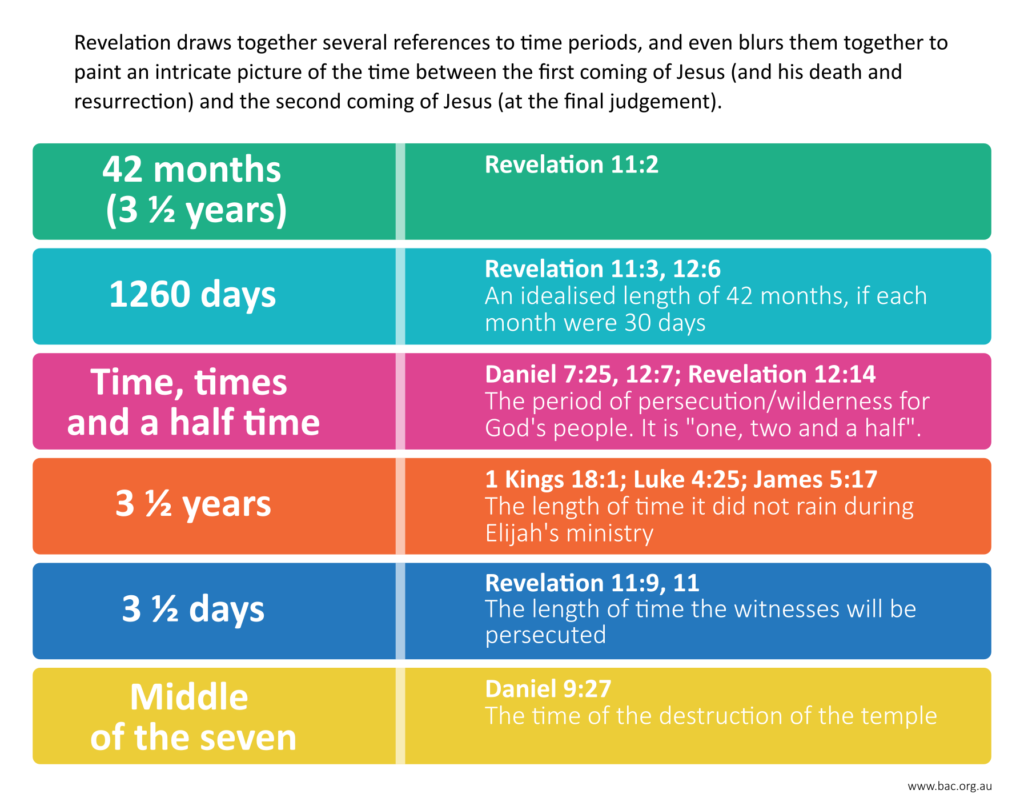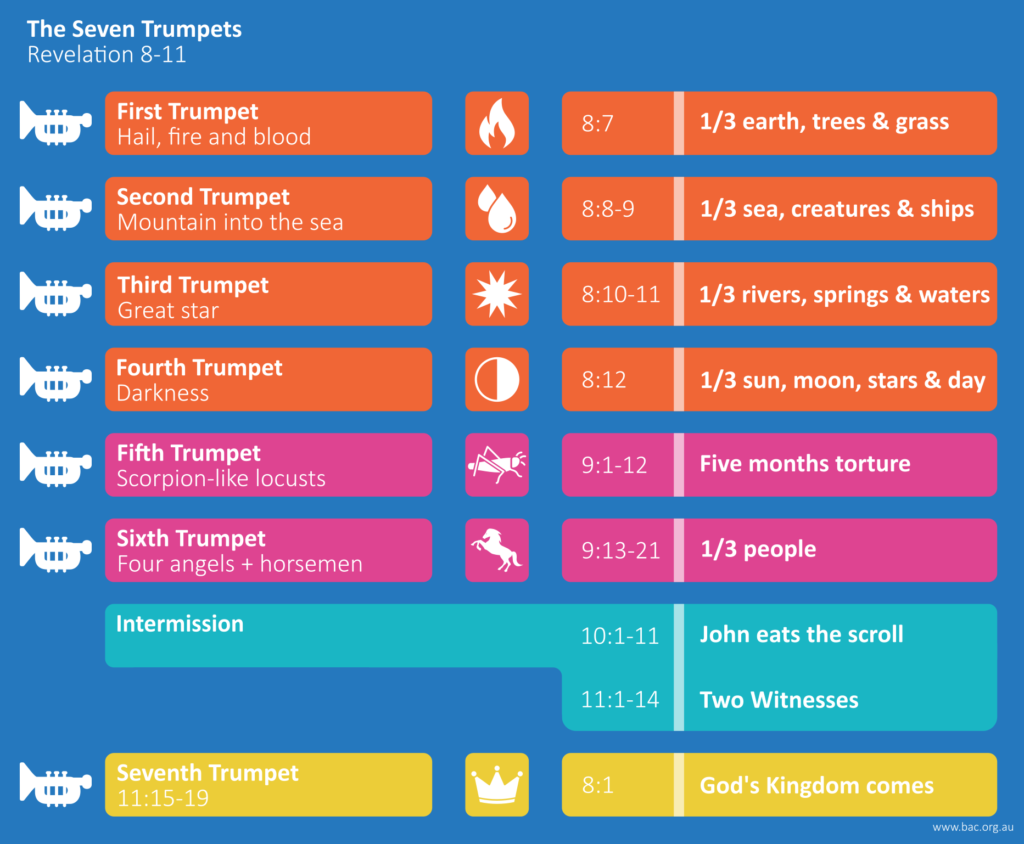Chapter eleven
The Two Witnesses
11 I was given a reed like a measuring rod and was told, “Go and measure the temple of God and the altar, with its worshipers. 2 But exclude the outer court; do not measure it, because it has been given to the Gentiles. They will trample on the holy city for 42 months. 3 And I will appoint my two witnesses, and they will prophesy for 1,260 days, clothed in sackcloth.” 4 They are “the two olive trees” and the two lampstands, and “they stand before the Lord of the earth.” 5 If anyone tries to harm them, fire comes from their mouths and devours their enemies. This is how anyone who wants to harm them must die. 6 They have power to shut up the heavens so that it will not rain during the time they are prophesying; and they have power to turn the waters into blood and to strike the earth with every kind of plague as often as they want.
This again reflects an aspect of Ezekiel’s ministry where the temple is measured (Ezekiel 40-42). The measuring of the temple in both Ezekiel and in Revelation signifies God’s ownership and protection of his people to dwell with him. It echoes the safety of God’s people being sealed in Revelation 7
The theme of measuring will come up again in an important passage in Revelation 21:15-17. This reference to Ezekiel’s ministry carries on from the parallel of John eating the scroll in Revelation 10:9, and likely represents the ‘sweet’ taste of the scroll.
Explore: The Two Witnesses

The two witnesses are described as two olive trees and two lampstands (Revelation 11:4). There is a significant amount of Old Testament imagery being symbolised in this passage.
Two witnesses were a requirement for any judgement on sin to be accepted (Deuteronomy 17:6, 19:51).
These two witnesses are described as having two powers. Firstly, “to shut up the heavens so that it will not rain”, a reference to the prophet Elijah in 1 Kings 17:1; 18:1. Secondly, “to turn the waters into blood and to strike the earth with every kind of plague, a reference to Moses in Exodus 7-12.
These two prophets, Moses and Elijah, also appeared at the transfiguration of Jesus in Luke 9:30. John was also present (Luke 9:28) There, a voice from heaven is heard that declares Jesus as God’s chosen son (Luke 9:35). In Revelation 11:12, we have a similar voice from heaven.
Whereas in the transfiguration story, Moses and Elijah represent “the Law and the Prophets”, here in Revelation their ministry of proclaiming both salvation and judgement is in view, as suggested by the power they are given in Revelation 11:6.
In Zechariah 4, Zechariah has a vision where two olive trees are described as the source of constant oil for the lamps at the temple. These are said to represent two servants of God (Zechariah 4:12-14). In that context, it is understood that these are Joshua and Zerubbabel.
Where the olive trees and lampstands are separate in Zechariah, Revelation 11:4 sees them as one and the same. Hence, the lampstands, which signified the church in Revelation 1:20, are themselves also the messengers of God’s salvation and judgement, signified by the ministry of Moses and Elijah. The church is taking on the prophetic role of proclaiming salvation and judgement to the world.
The movement between the 3 ½ years in Revelation 11:3 to 3 ½ days in Revelation 11:9, 11 further suggests that the experience described for these two symbolic individuals is representative of the experience of the church between the first and second coming of Jesus (as per Daniel 9:27).
Though God’s people may suffer, and even be killed for their faith, there is hope for a resurrection at the end of time – when this 3 ½ day period between Jesus’ first and second coming is over (Revelation 11:11).
Explore: 42 Months

42 months is the equivalent of 3 ½ years. This number carries a number of symbolic ideas of a time of tribulation and judgement.
Firstly, it is the equivalent to the phrase ‘a time, times and a half time’ in Daniel 7:25, 12:7, which describe the length of time the people will be handed over to suffer. This is also referred to in Revelation 12:14.
Secondly, it is the length of time that it did not rain in Elijah’s ministry (1 Kings 18:1; Luke 4:25; James 5:17).
Thirdly, it is also the number of camps recorded that Israel used as they wandered in the wilderness with Moses in Numbers 33.
Fourthly, it represents half of seven years, which points to a definitive end of suffering (If it were seven years, it would suggest complete and endless suffering).
Fifthly, in Daniel 9:27, an important act occurs during the final ‘seven’, part of a collection of 70 ‘sevens’. Halfway through this final seven, the temple is destroyed. Thus, the last period before the final judgement is 3 ½ in length.
All of these allusions are likely involved in the numbering used in this section in Revelation. And certainly a lot of symbolism is especially drawn from the final chapters in Daniel. It is likely best to understand this period of 42 months as the time between Jesus’ first and second comings – the final 3 ½ referred to in Daniel 9 – a time of great persecution and suffering for the church, but one with wonderful hope concerning its conclusion.
7 Now when they have finished their testimony, the beast that comes up from the Abyss will attack them, and overpower and kill them. 8 Their bodies will lie in the public square of the great city—which is figuratively called Sodom and Egypt—where also their Lord was crucified. 9 For three and a half days some from every people, tribe, language and nation will gaze on their bodies and refuse them burial. 10 The inhabitants of the earth will gloat over them and will celebrate by sending each other gifts, because these two prophets had tormented those who live on the earth.
Explore: The Beast

This is the first appearance of ‘the beast’ in Revelation. All we are told here is that he comes up from the Abyss, the source of the previous locust plague (Revelation 9:3-4) and the home of the “angel of the Abyss” (Revelation 9:11).
The beast draws upon the imagery of the fourth beast in Daniel 7:7-12.
The beast is able to overpower and kill the witnesses. While God’s people are protected from the wrath of God, they may still face the harsh treatment of the beast. Yet, to die at the hand of the beast is not defeat, for there will come ultimate victory in the resurrection, as highlighted in Revelation 11:11.
The beast image will appear again in chapters 13, 17 and 19.
11 But after the three and a half days the breath of life from God entered them, and they stood on their feet, and terror struck those who saw them. 12 Then they heard a loud voice from heaven saying to them, “Come up here.” And they went up to heaven in a cloud, while their enemies looked on.
13 At that very hour there was a severe earthquake and a tenth of the city collapsed. Seven thousand people were killed in the earthquake, and the survivors were terrified and gave glory to the God of heaven.
14 The second woe has passed; the third woe is coming soon.
Explore: The Seventh Trumpet

As mentioned in Revelation 10:7, the sounding of the seventh trumpet signals the end of time. Whereas the final seal being opened brought silence for half an hour, the seventh trumpet brings a contrast with the praise of God from the voices in heaven and from the elders.
The description here connects back to the picture of the heavenly throne room in Revelation 4, where we first met the 24 elders.
The song of the heavenly voices reflects both the song of the angels in Revelation 7:12 and the song of the great multitude in Revelation 19. Thus, what began with the angels grows through Revelation to see all God’s people singing his praises as the ruling king.
15 The seventh angel sounded his trumpet, and there were loud voices in heaven, which said:
“The kingdom of the world has become
the kingdom of our Lord and of his Messiah,
and he will reign for ever and ever.”
16 And the twenty-four elders, who were seated on their thrones before God, fell on their faces and worshiped God, 17 saying:
“We give thanks to you, Lord God Almighty,
the One who is and who was,
because you have taken your great power
and have begun to reign.
18 The nations were angry,
and your wrath has come.
The time has come for judging the dead,
and for rewarding your servants the prophets
and your people who revere your name,
both great and small—
and for destroying those who destroy the earth.”
19 Then God’s temple in heaven was opened, and within his temple was seen the ark of his covenant. And there came flashes of lightning, rumblings, peals of thunder, an earthquake and a severe hailstorm.
Explore: Temple in Heaven

The temple, measured at the beginning of the chapter, comes into view once more. As the temple is opened, it also casts our mind back to the first scene of the heavenly throne room in Revelation 4:1.
The ark of the covenant was an Old Testament symbol of God’s presence in the most holy place in the temple. It contained the 10 commandments, a jar of manna and Aaron’s rod. The description of the storm is also a common image used for God’s presence in the Old Testament, including with Moses at Mount Sinai when he receives the 10 commandments (Exodus 19:16, 20:18).
In Old Testament times, only the high priest could enter the most holy place, once per year on the Day of Atonement.
The opening of the temple in heaven portrays God coming into the presence of his people. God’s kingdom and God’s people are coming together, as they sung of in Revelation 11:15.
This whole image will be returned to again in Revelation 21, where it is described even more vividly.
Scripture quotations taken from The Holy Bible, New International Version® NIV®
Copyright © 1973, 1978, 1984, 2011 by Biblica, Inc.
Used with permission. All rights reserved worldwide.